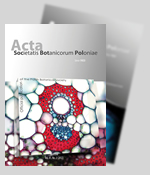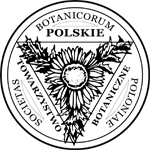Taxonomic significance of achene morphology of selected Rosa taxa (Rosaceae) occurring in Poland
Abstract
Keywords
Full Text:
PDFReferences
Rehder A. Manual of cultivated trees and shrubs hardy in North America. 2nd ed. Berlin: Springer; 1960.
Hutchinson J. The genera of flowering plants: dicotyledons. Vol. 1. Oxford: Clarendon Press; 1964.
Zieliński J. Rodzaj Rosa L. Warszawa: Państwowe Wydawnictwo Naukowe; 1987. (Flora Polski. Rośliny Naczyniowe; vol 5).
Nilsson O. Rosa. In: Davis PH, editor. Flora of Turkey and the East Aegean Islands. Vol. 4. Edinburgh: Edinburgh University Press; 1997. p. 106–128.
Henker H. Rosa L. In: Conert HJ, Jäger EJ, Kadereit JW, Schultze-Motel W, Wagenitz G, Weber HE, editors. Hegi Illustrierte Flora von Mitteleuropa, 4(2C). Berlin: Parey Buchverlag; 2000.
Wissemann V. Conventional taxonomy of wild roses. In: Roberts A, Debener T, Gudin S, editors. Encyclopedia of rose science. London: Academic Press; 2003. p. 111–117. http://dx.doi.org/10.1016/B0-12-227620-5/00019-7
Kalkman C. Rosaceae. In: Kubitzki K, editor. Flowering plants – dicotyledons: Celastrales, Oxalidales, Rosales, Cornales, Ericales. Berlin: Springer; 2004. p. 343–386. (The Families and Genera of Vascular Plants; vol 6).
Buzunova I, Zieliński J, Romo A. Rubus rubiginosa (Rosaceae) in Morocco – first records from northern Africa. Dendrobiology. 2011;66:99–103.
Klaštersky I. Rosa L. In: Tutin TG, Heywood VH, Burges NA, Moore DM, Valentine DH, Walters SM, et al., editors. Flora Europaea. Vol. 2. Cambridge: Cambridge University Press; 1968. p. 25–32.
Zieliński J. Studia nad rodzajem Rosa L. – systematyka sekcji Caninae DC em Christ. Arboretum Kórnickie. 1985;30:3–109.
Fougere-Danezan M, Joly S, Bruneau A, Gao X, Zhang L. Phylogeny and biogeography of wild roses with specific attention to polyploids. Ann Bot. 2014;115(2):275–291. http://dx.doi.org/10.1093/aob/mcu245
Lawrence GHM. Taxonomy of vascular plants. New York, NY: The Macmillan Company; 1958.
Takhtajan A. Diversity and classification of flowering plants. New York, NY: Columbia University Press; 1997.
Angiosperm Phylogeny Group. An update of the Angiosperm Phylogeny Group classification for the orders and families of flowering plants: APG II. Bot J Linn Soc. 2003;141(4):399–436. http://dx.doi.org/10.1046/j.1095-8339.2003.t01-1-00158.x
Kubitzki K. Flowering plants – dicotyledons: Celastrales, Oxalidales, Rosales, Cornales, Ericales. Berlin: Springer; 2004. (The Families and Genera of Vascular Plants; vol 6).
Potter D, Eriksson T, Evans RC, Oh S, Smedmark JEE, Morgan DR, et al. Phylogeny and classification of Rosaceae. Plant Syst Evol. 2007(1–2);266:5–43. http://dx.doi.org/10.1007/s00606-007-0539-9
Spjut RW. A systematic treatment of fruit types. Mem N Y Bot Gard. 1994;70:1–182.
Stace C. New flora of the British Isles. 3nd Edition. Cambridge: Cambridge University Press; 2010.
Zieliński J, Guzicka M, Tomaszewski D, Maciejewska-Rutkowska I. Pericarp anatomy of wild roses (Rosa L., Rosaceae). Flora. 2010;205(6):363–369. http://dx.doi.org/10.1016/j.flora.2009.12.002
Starikova VV. Morphological-anatomical characteristics of the nutlets in some Rosa species. Bot Zhurn. 1973;58:893–898.
Starikova VV. Morphological-anatomical characteristics of nutlets in some species of Rosa (Rosaceae). Botanichesky Zhurnal. 1983;68:522–524.
Artjushenko ZT, Feodorov AA. Organographia illustrata plantarum vascularium: fructus. Leningrad: Nauka; 1986.
Khrzhanovskii VG, Ponomarenko SF, Kolobov ES. Mikromorfologicheskaya kharakteristika plodov shipovnika v svyazi s sistematikoi roda Rosa L. Bulletin Glavnogo Botanicheskogo Sada. 1985;137:47–53.
Guzicka M, Zieliński J, Tomaszewski D, Gawlak M. Anatomical study on the developing pericarp of selected Rosa species (Rosaceae). Dendrobiology. 2012;68:77–87.
Starikova VV. Anatomo-morphological characteristics of nuts of Rosa rugosa Thunb. in the process of their development. Botanichesky Zhurnal. 1975;60:558–563.
Starikova VV. Morphologo-anatomical characterization of nutlets of some Rosa species (Rosaceae). Botanichesky Zhurnal. 1977;62:1500–1504.
He H, Ueda Y, Kurosawa T, Ogawa S, Nishino E, Wang B, et al. Morphological character and germination in achenes of Rosa persica Michx. Acta Hortic. 2001;547:129–140. http://dx.doi.org/10.17660/ActaHortic.2001.547.16
Dowidar AE, Loutfy MHA, Kamel EA, Ahamed AHM, Hafez HHL. Studies on the Rosaceae I. Seed and/or achene macro and micromorphology. Pak J Biol Sci. 2003;6:1778–1791. http://dx.doi.org/10.3923/pjbs.2003.1778.1791
Tantawy ME, Naseri MM. A contribution to the achene knowledge of Rosoideae (Rosaceae) LM and SEM. Int J Agric Biol. 2003;5:105–112.
Bojňanský V, Fargašová A. Atlas of seeds and fruits of Central and East-European flora. The Carpathian Mountains region. Dordrecht: Springer; 2007.
Bruneau A, Starr JR, Joly S. Phylogenetic relationships in the genus Rosa: new evidence from chloroplast DNA sequences and an appraisal of current knowledge. Syst Bot. 2007;32(2):366–378. http://dx.doi.org/10.1600/036364407781179653
Yokota K, Roberts AV, Mottley J, Lewis R, Brandham PE. Nuclear DNA amounts in roses. Ann Bot. 2000;85:557–561. http://dx.doi.org/10.1006/anbo.1999.1102
Scariot V, Akkak A, Botta R. Characterization and genetic relationship of wild species and old garden roses based on microsatellite analysis. J Am Soc Hortic Sci. 2006;131(1):66–73.
Weidema I. NOBANIS – invasive alien species fact sheet – Rosa rugosa. Online Database of the European Network on Invasive Alien Species [Internet]. 2006 [cited 2015 Feb 14]. Available from: https://www.nobanis.org/globalassets/speciesinfo/r/rosa-rugosa/rosa_rugosa.pdf
Kurtto A, Lampinen R, Junikka L. Atlas Florae Europaeae. Distribution of vascular plants in Europe. Vol. 13. Rosaceae (Spiraea to Fragaria, excl. Rubus). Helsinki: The Committee for Mapping the Flora of Europe and Societas Biologica Fennica Vanamo; 2004.
Bruun HH. Biological flora of the British Isles. No. 239. Rosa rugosa Thunb. ex Murray. J Ecol. 2005;93:441–470. http://dx.doi.org/10.1111/j.1365-2745.2005.01002.x
Essl F. Rosa rugosa Thunb. ex Murray (Rosaceae, Magnoliophyta). In: Drake JA, editor. Handbook of alien species in Europe. Berlin: Springer; 2008. p. 358.
Tokarska-Guzik B, Dajdok Z, Zając M, Zając A, Urbisz A, Danielewicz W, et al. Rośliny obcego pochodzenia w Polsce ze szczególnym uwzględnieniem gatunków inwazyjnych. Warszawa: Generalna Dyrekcja Ochrony Środowiska; 2012.
Stearn WT. Botanical Latin: history, grammar, syntax, terminology, and vocabulary. 4th ed. Newton Abbot: David & Charles; 1992.
Andenberg AL. Atlas of seeds and small fruits of Northwest-European plant species (Sweden, Norway, Denmark, East Fennoscandia and Iceland) with morphological descriptions. Part 4: Resedaceae-Umbelliferae. Stockholm: Swedish Museum of Natural History; 1994.
Seidler-Łożykowska K, Bocianowski J. Evaluation of variability of morphological traits of selected caraway (Carum carvi L.) genotypes. Ind Crops Prod. 2012;35:140–145. http://dx.doi.org/10.1016/j.indcrop.2011.06.026
Strik BC, Proctor JTA. Relationship between achene number, achene density, and berry fresh weight in strawberry. J Am Soc Hortic Sci. 1988;113:620–623.
DOI: https://doi.org/10.5586/asbp.3493
|
|
|







